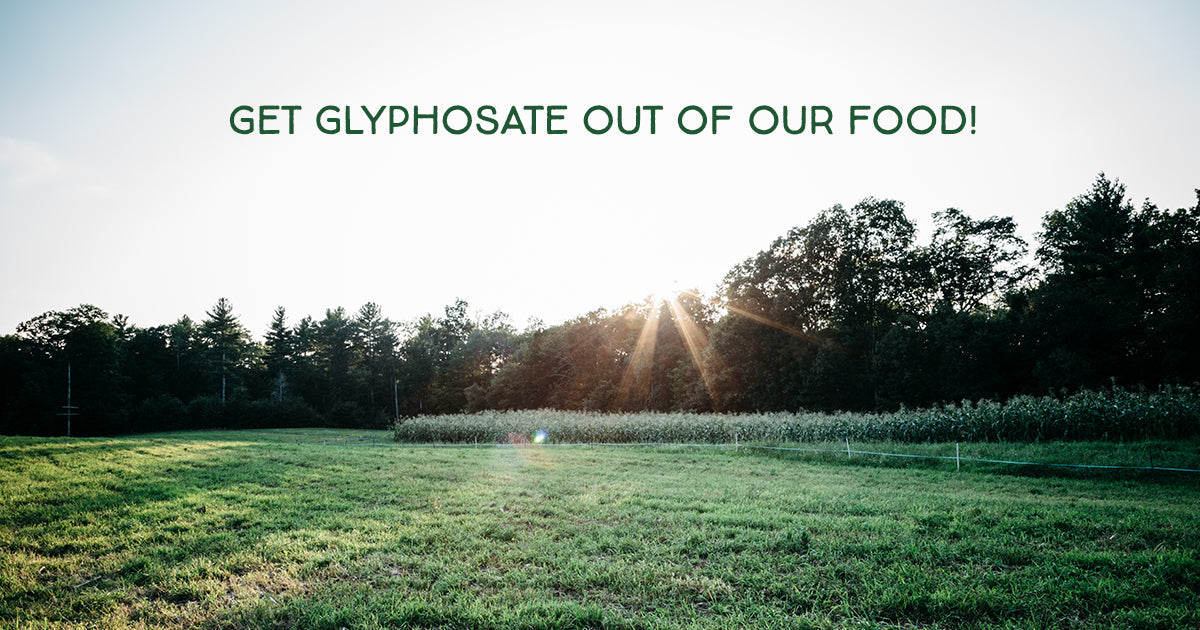The good, the bad, and the ugly: A glyphosate glossary

| Bethany Davis, MegaFood Director of Advocacy & Government Affairs | September 28, 2018 |
MegaFood is leading the charge to get the Environmental Protection Agency (EPA) to ban glyphosate as a desiccant in the production of conventional crops such as oats and wheat, a process that introduces the herbicide into our everyday food. Topping our list of priorities is building a big ‘ole action network of health and wellness professionals and concerned citizens.
If you fall into this latter group, you may be unfamiliar with some of the terms used in the conversation about glyphosate’s impact on human and soil health. Let’s take care of that little learning curve right now, shall we?
Your glossary on glyphosate
First up, a working definition of the star of our show:
Glyphosate:
Here’s something most people don’t know: glyphosate was originally used to decalcify pipes. No wonder it does a great job as a mineral chelator! Introduced for weed control in 1974, it works by inhibiting an enzyme found in plant life, fungi, bacteria, and algae that is responsible for producing essential amino acids necessary for non-mammalian species to thrive. Most die or stop growing after exposure. Today, glyphosate is everywhere, and it’s not “just” an herbicide. It is a broad-spectrum antibiotic and mineral chelator that immobilizes nutrients and kills microbial life in the soil. The application of glyphosate as a desiccant takes the herbicide beyond its main purpose of being used in GMO crop production. It is sprayed directly on non-GMO, conventionally-grown crops, like wheat and oats, during harvest. This process speeds up the drying to allow farmers to reap crops more efficiently than they could naturally. In 2015, the World Health Organization (WHO) listed glyphosate as a “probable” carcinogen.
Whew, that’s a lot to absorb. Now, let’s take up the highlighted terms, along with a few other key terms not included in the above paragraph but critical to an informed discussion of the issues.
Herbicide:
Merriam-Webster defines a herbicide as “an agent used to destroy or inhibit plant growth.” In industrial farming practice, herbicides are applied to crops both as a weed killer and, with a growing number of conventional crops such as oats, wheat, barley, and other grains, as a desiccant. *Interesting fact: per EPA definition, herbicides are actually considered a class of pesticides.
Mineral Chelator:
Glyphosate is a patented chelating agent, binding to minerals in the soil and preventing the uptake of nutrients by the plants themselves. This means that the food grown in soil sprayed with glyphosate will be devoid of, or seriously diminished in, vital nutrients such as iron, manganese, zinc, and boron.
Broad-Spectrum Antibiotic:
An antibiotic is a medicine that inhibits the growth of or destroys microorganisms. The term is in contrast to a narrow-spectrum antibiotic that is effective against only a specific group of bacteria. The downside to broad-spectrum antibiotics is that in addition to killing disease-causing bacteria, they can kill or disrupt the native, normal bacteria that are critical to healthy functioning in all living things.
Microbial Life:
Each person has a personalized collection of bacteria, called the microbiome. We’re born with some of it, build it up as we grow, and often turn to supplemental probiotics to promote a healthy colony of beneficial bacteria, as this microbial life performs a number of vital functions. These range from developing and regulating our body’s immune system, to breaking down carbohydrates and toxins to help us absorb the fatty acids cells needed to grow. Bacteria help protect the cells in our intestines from invading pathogens and also promote repair of damaged tissue. Most importantly, good bacteria prevents bad bacteria from growing and causing disease.
Microbial life also flourishes in healthy soils as beneficial bacteria that literally wrestles nutrients from solid rock and makes them available to plants and, ultimately, to us.
Desiccant:
A desiccant is a substance with a special affinity for water and is used as a drying agent. In industrial farming practice, specially treated herbicides that include the desiccant glyphosate are sprayed on crops a week or so prior to harvest. Doing so dries out the crop and makes it easier to reap than non-chemical means of drying. One way glyphosate enters the food chain is through trace elements left on crops following desiccation.
World Health Organization (WHO):
We included WHO because, frankly, we needed more examples of “good,” but also because WHO works to establish the highest standards of health for all people regardless of race, religious, political belief, and economic or social condition.
Carcinogen:
A substance capable of causing cancer in living tissue. The WHO designated glyphosate as a “probable” carcinogen, the agency’s third-highest rating.
Super Weeds:
An alarming environmental trend is an emergence of “super weeds” that are resistant to glyphosate. This results in a vicious cycle whereby ever increasing amounts, types, and potencies of herbicide applications are required to combat weeds. The safe limit established by the environmental protection agency for glyphosate exposure is higher in the United States than in other countries.
Glyphosate Residue Free (GRF):
MegaFood is proud to be the first supplement brand to have its entire line certified Glyphosate Residue Free by The Detox Project, an independent research and certification organization dedicated to bringing awareness to the public by testing consumer goods and food products for toxic chemicals. We’re issuing a friendly challenge to other supplement brands out there to do the same—what’s good for the planet is good for all of us.
Regenerative Agriculture:
And speaking of something that’s good for everybody, regenerative agriculture offers an approach to food and farming systems that rejects pesticides and artificial fertilizers and aims to regenerate topsoil, increase biodiversity, and strengthen the health and vitality of farming and ranching communities, all while drawing down carbon from the atmosphere, where there’s too much of it, to the soil, where there’s too little of it.
It’s great to be able to end on a positive note. But there’s a lot of work to do to get to this happy place, and we can’t do it without you. So, if you haven’t signed our petition to the EPA yet, please do so and help us kick glyphosate to the curb.
Thanks for taking the time to further inform yourself, and support this important effort. (The soil thanks you, too!)
Does the glyphosate-gut connection leave you questioning your digestive health?
Learn more about your microbiome -and how to help it thrive- here.



Leave a comment
This site is protected by hCaptcha and the hCaptcha Privacy Policy and Terms of Service apply.